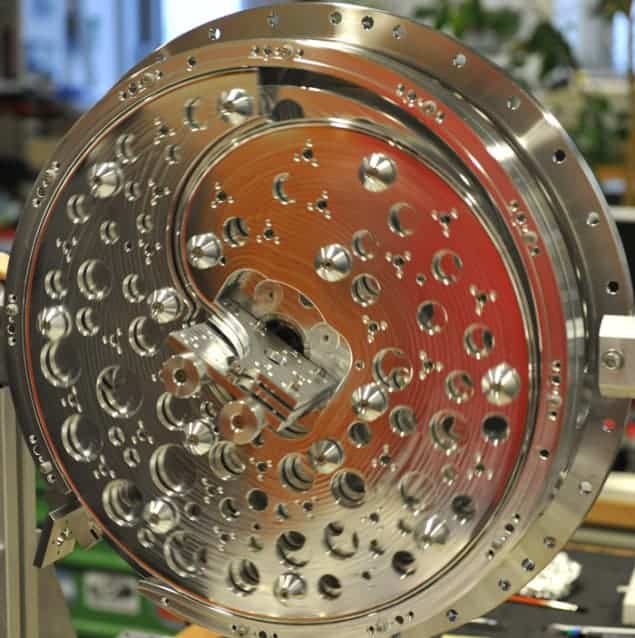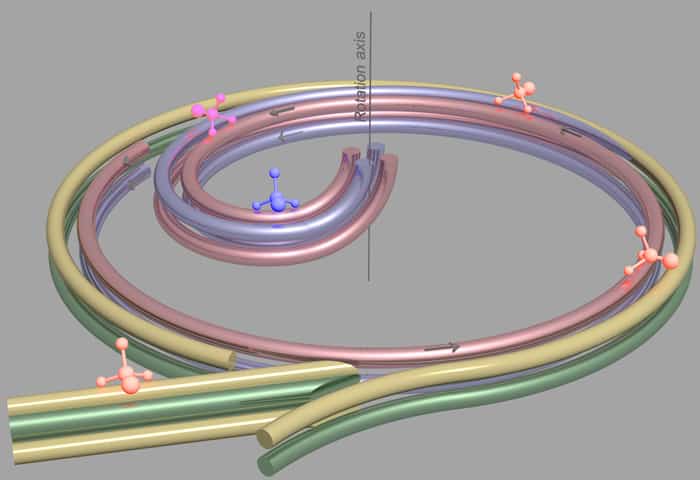
Physicists in Germany have developed a technique for producing the first ever near-continuous beams of molecules slowed and cooled to a temperature of just one degree above absolute zero. The method, which involves running the molecules through a centrifuge, could help provide new insights into quantum states of matter and even allow physicists to work out if the electron has an electric dipole moment. The beams could also prove useful in studying chemical reactions that occur when molecules collide.
While physicists have enjoyed great success in chilling ensembles of some atoms down to nanokelvin temperatures, molecules have proved much more difficult to cool. What physicists normally do is to first create a very slow beam of cold molecules, which they can then trap and cool further. However, all the deceleration techniques developed so far create pulsed beams of slow molecules in which the beam is “on” for less than 1% of the time. While pulses are fine for some applications, most techniques for making ultracold molecular gases would benefit from a large continuous flux of cold molecules.
Molecular merry-go-round
Now, however, Sotir Chervenkov and colleagues at the Max Planck Institute for Quantum Optics in Garching, Germany, have come up with a clever way of slowing down molecules that yields a nearly continuous beam. Its fundamental principle is familiar to anyone who has been on a playground merry-go-round. If you start at the edge of the spinning platform and try to move to the centre, you are opposed by the centrifugal force pushing you outwards.

In the new system, molecules are injected into a spiral path that goes from the outer edge of a spinning turntable (diameter 40 cm) to its centre. The path is defined by a quadrupole arrangement of electrodes (see figure above). Initially moving at about 200 m s–1, the molecules are slowed by their battle against the centrifugal force and emerge from the centre of the turntable moving at about 20 m s–1. The researchers have so far created a range of continuous ultracold beams, including beams from fluoromethane.
An important feature of the device is that the flow is nearly continuous and only interrupted briefly at one point in the rotation cycle. Most of the emerging molecules have kinetic energies that correspond to a temperature of less than 1 K. This means that if the molecules were subsequently collected in a trap, the resulting gas would have a temperature below 1 K.
Further cooling
The centrifuge could be used to deliver abundant quantities of slow molecules, which could then be further cooled using methods such as evaporative cooling or the Sisyphus technique. The latter was unveiled in 2012 by a team a Garching led by Martin Zeppenfeld and is capable of creating molecular gases with temperatures as low as 30 mK.
“The centrifuge holds promise for delivering abundant samples of slow molecules, which could be further cooled down en route to achieving quantum-degenerate regimes with polar molecules,” explains Chervenkov. He also points out that the cold beams could be used to do experiments involving the low-energy collisions of molecules, which give important insights into the role of quantum tunnelling in chemical reactions.
Team member Gerhard Rempe adds that the technique could be applied to other cooling applications. “The universality of the centrifugal force might also enable one to slow down atoms that cannot be laser cooled, and possibly even cold neutrons,” he says.
The centrifuge is described in Physical Review Letters.



